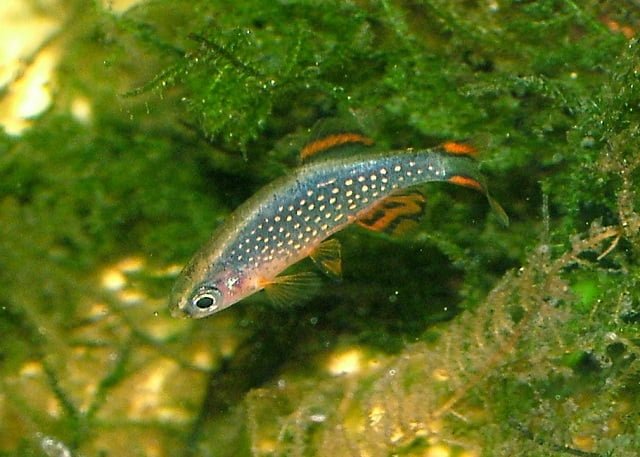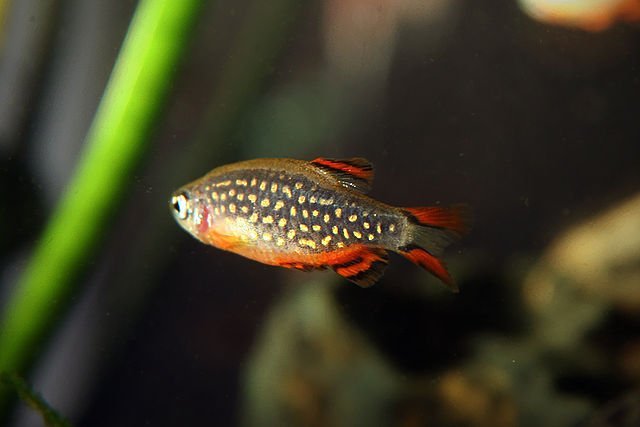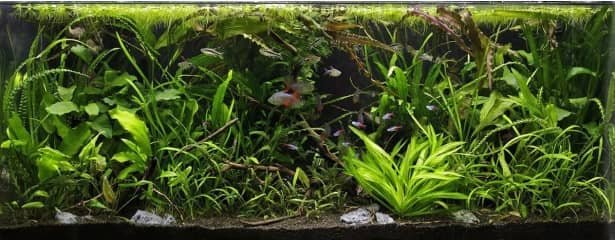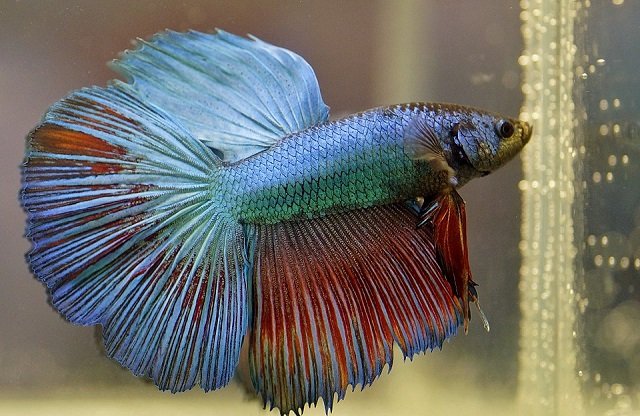
The Galaxy Rasbora (Danio margaritatus), also known as the “Celestial Pearl Danio,” has become a popular species among aquarists due to its calm temperament and unique characteristics, but most importantly, because it is the ideal ornamental fish for planted aquariums.
The body coloration, reminiscent of galaxies, and its ease of breeding are among the reasons why the Galaxy Rasbora is one of the most sought-after aquatic ornamental species by enthusiasts.
In this article, we aim to share information about the breeding, feeding, care, compatibility, and main diseases affecting Celestial Pearl Danios.
Taxonomy of the Galaxy Rasbora
- 1 Taxonomy of the Galaxy Rasbora
- 2 Natural Habitat of the Celestial Pearl Danio
- 3 Physical Characteristics of Danio margaritatus
- 4 Breeding of Galaxy Rasbora
- 5 Feeding the Galaxy Rasbora
- 6 Caring for the Galaxy Rasbora
- 7 Compatibility of the Galaxy Rasbora
- 8 Diseases that affect the Galaxy Rasbora
- 9 Conclusion
- 10 References
- 11 Entradas relacionadas:
The common name “Galaxy Rasbora” originates from the fish’s galaxy-like body appearance. However, in recent years, the name “Celestial Pearl Danio” has gained more prominence (Edmond, 2020).
It is also important to note that when the species was discovered in 2006, it was given the scientific name Microrasbora sp. However, researchers later determined that this fish species is more closely related to the Danio genus than to Rasboras. Conway et al., (2008) concluded that Celestichthys margaritatus should be reclassified under the Danio genus, renaming it Danio margaritatus. This conclusion was based on morphological and molecular evidence indicating a close relationship between C. margaritatus and other Danio species.
Below is the current taxonomy of the species:
- Phylum: Chordata
- Class: Actinopterygii
- Order: Cypriniformes
- Family: Cyprinidae
- Subfamily: Danioninae
- Genus: Danio
- Scientific Name: Danio margaritatus
- Synonym: Celestichthys margaritatus
- Spanish Names: Rasbora galaxy, microrasbora galaxy, danio perla celestial.
- English Names: Galaxy Rasbora, Celestial Pearl Danio, Celestial Pearl Albino, Fireworks Rasbora
Natural Habitat of the Celestial Pearl Danio
The Celestial Pearl Danio (Danio margaritatus) originates from the Salween River basin in Lake Inle (Myanmar) and northern Thailand, where it was discovered in 2006. Celestial Pearl Danios inhabit freshwater ponds surrounded by rice fields and grasslands.
In their natural habitat, Galaxy Rasboras thrive in waters with abundant aquatic vegetation, mainly stem plants. Species from the Hydrocharitaceae family, such as Elodea and Anacharis, have been identified in these areas. Unfortunately, wild populations of Galaxy Rasboras have been drastically reduced due to high demand from aquarists, leading to the destruction of their natural environment.
Stay Always Informed
Join our communities to instantly receive the most important news, reports, and analysis from the aquaculture industry.
If you wish to purchase Galaxy Rasbora specimens, ensure they come from breeders who raise them in controlled environments.
Physical Characteristics of Danio margaritatus
The Celestial Pearl Danio (Danio margaritatus) is a small and striking fish with distinctive features in its appearance, behavior, and habitat.
- Size: A very small fish, with a standard length between 2 and 2.5 cm, though some may reach 3 cm.
- Shape: It has a stout body with a notably blunt snout. Its body length is approximately three times its height.
- Coloration: Male Danio margaritatus exhibit a deep blue base color (dull greenish-blue in females). Their bodies are dotted with small, pearl-like white or cream spots. Their fins have bright red stripes outlined in dark blue, and their bellies are bright red. Female Galaxy Rasboras, on the other hand, are slightly duller in coloration, with whitish bellies and no spots. Males also have a taller caudal peduncle compared to females.
- Sexual Dimorphism: Males are typically more colorful and slimmer than females, which are rounder. During the breeding season, males show a bright orange color in their fins that extends to the underside of their bellies.
- Lifespan: 3 to 5 years.
Breeding of Galaxy Rasbora
The breeding of the Celestial Pearl Danio (Danio margaritatus) is an interesting and relatively easy process to observe in an aquarium, provided certain conditions are met. These fish can start breeding as early as 3 months of age (Iskandar et al., 2022); however, it is recommended to use more mature specimens for breeding processes. Below are the most important aspects of their reproduction:
Male vs. Female Galaxy Rasbora
Male and female Galaxy Rasboras exhibit noticeable differences in appearance, particularly in coloration and body shape. These differences, known as sexual dimorphism, are essential for distinguishing sexes and understanding their reproductive behavior.
Table 01. Male vs. Female Galaxyy rasbora (Danio margaritatus).
| Characteristic | Males | Females |
|---|---|---|
| Coloration | More intense and vibrant blue color. Fins with black stripes and bright red or orange. Brighter red abdomen during courtship. Possible red stripe from the head to the dorsal fin. Brighter fins. | Less intense blue, bluish-green, or golden color. Fins with a pale orange tone. Whitish-yellow or golden abdomen, sometimes with an orange hue. |
| Body Shape | Slender and more streamlined. Higher caudal peduncle. | Rounder and thicker body, especially when gravid. Generally larger than males. |
| Spots and Markings | Brighter and more defined white spots or “pearls” spread throughout the body. | Less intense spots, not extending as far on the abdomen. |
| Anal Fin | No special characteristics. | During reproductive age, a dark spot may develop near the anal fin. |
| Jaw | Small black pad on the edges of the lower jaw. | No pad or a much smaller one. |
Spawning Behavior
- Galaxy rasboras are egg scatterers, meaning the females release their eggs into the water to be fertilized by the males.
- They exhibit no parental care, meaning they do not protect their eggs or offspring. In fact, adults will eat the eggs and larvae if given the chance.
- They do not have a specific breeding season and can spawn almost daily under suitable conditions. The number of eggs laid by each female depends on the condition of the female.
- Males court females by chasing them and displaying their brightest colors. During the breeding period, the males’ orange coloration extends to the lower abdomen.
- Males may compete for the attention of females and try to defend a patch of dense vegetation for spawning.
- When a female is ready, the pair moves among plants or substrate to deposit and fertilize the eggs.
- Spawning Substrate: Prama et al., (2023) used unraveled raffia with stones as a spawning substrate. This provided an appropriate site for females to deposit their eggs.
- The spawning process can be repeated multiple times if the fish have been conditioned or only once or twice if allowed to spawn daily (Hellweg, 2020). However, it is advisable to let the breeding fish “rest” between spawning periods.
- Other males may attempt to follow the pair during spawning to fertilize or eat the eggs.
Eggs
- The eggs are small, clear, and slightly adhesive, spreading across vegetation or other aquarium substrates.
- Each female can lay about 30 eggs per spawning event, although breeders have reported counts ranging from 18 (Prama et al., 2013) to 50 eggs from a large female. Petrov et al., (2016) recommends using thiochrome (15 nmol/L) to increase egg production by 34%.
- The eggs are approximately 1 mm in size, slightly smaller than the spots on their bodies.
Hatching and Fry Development
- The eggs hatch within 3 to 5 days, or 5 to 10 days depending on water temperature, typically within 72 hours. At a water temperature of 24 to 25°C, galaxy rasbora larvae hatch after 3 to 4 days.
- Newly hatched larvae are dark and cryptic, hiding among substrate and debris for about three days post-hatching.
- Afterward, the fry become clearer and start free-swimming, feeding on microorganisms in the aquarium, such as infusoria. Iskandar et al., (2024) recommends a density of 2 fish per liter (PT2) as optimal for the growth and survival of galaxy rasbora larvae.
- The fry require a particularly small diet, less than 50 µm.
- It is recommended to feed the fry live food such as infusoria (Iskandar et al., 2022), microalgae, and vinegar eels initially, transitioning to brine shrimp nauplii as they grow.
- The fry grow quickly, beginning to show adult coloration at 9 to 10 weeks of age and reaching adult size between 12 and 14 weeks.
- The fry can reproduce as early as 11 to 12 weeks of age.
Recommendations for Breeding in Aquariums
- To protect eggs and larvae from adults, it is recommended to provide dense vegetation for spawning, such as Java moss, fine-leaf plants, or spawning mops. Spawning grids can also be used.
- For controlled breeding, it is best to move the parents to a breeding tank with plants and then remove them after spawning to prevent them from eating the eggs.
- Alternatively, the spawning material with the eggs can be transferred to another tank for hatching and fry development.
- A larger tank is recommended for breeding rather than a nano tank, with a group of at least 10 galaxy rasboras.
- Care must be taken not to include other fish or shrimp in the breeding tank, as they may eat the eggs or larvae.
- The fry will need very small live food from day one.
- It is important to ensure the tank is established and mature, as this ensures the availability of microorganisms for the fry.
- A sponge filter or a filter intake cover is recommended in the breeding tank to prevent the fry from being sucked into the filter.

Feeding the Galaxy Rasbora
Galaxy rasboras have a varied diet as they are omnivores. In their natural habitat, they feed on small invertebrates, zooplankton, algae, and plant matter. In an aquarium, they accept a wide range of foods, both live and prepared.
Here are some key points about their diet:
- Live Foods: They enjoy newly hatched brine shrimp, daphnia, copepods, microworms, mosquito larvae, Tubifex sp., and white worms. These foods, in addition to being nutritious, help maintain their vibrant colors.
- Frozen Foods: They also enjoy frozen foods like daphnia and cyclops.
- Dry Foods: They can be fed finely crushed flakes or small pellets designed for micro fish. High-quality foods are recommended.
- Variety: Offering a varied diet is important to ensure they receive all the necessary nutrients to stay healthy.
- Feeding Frequency: It is recommended to feed them once or twice a day in small portions to prevent overfeeding. Galaxy rasboras have small stomachs, so several small meals are preferable to one large meal per day.
- Fry Feeding: Galaxy rasbora fry are very small and require special food such as infusoria, green water, or vinegar eels at first. Later, newly hatched brine shrimp can be offered, as they are rich in healthy fats and proteins for growth.
It is important to note that galaxy rasboras have very small mouths, so the food size must be appropriate. Additionally, they tend to feed in the middle and upper parts of the aquarium, so slow-sinking foods are recommended. Observing their feeding behavior ensures they are eating properly.
Caring for the Galaxy Rasbora
Rasbora galaxy prefers living in schools of 10 or more fish. It is best to keep more females than males in an aquarium because males will fight over females. A breeding tank for galaxy rasboras should have a minimum volume of 10 gallons to house 5 to 7 fish. A rule used by aquarists for this species is 2 gallons of water per fish (Yang, 2022).
As reported by Hellweg (2020), in small tanks, a single male can kill all other males within a few days until only one remains. Although you may keep galaxy rasboras in small aquariums, their well-being might not be optimal.
Danio margaritatus prefers living in the lower strata of the tank, where it hides among rocks and aquatic plants. To mimic their natural habitat (a planted aquarium), it is important to include a variety of aquatic plants such as anubias, elodea, egeria, Java fern, bacopa, and rotala, as they naturally inhabit shallow ponds rich in vegetation.
According to Hutabarat (2020), the stocking density that provides the best growth rates for Danio margaritatus is 5 fish per liter when raised at an average salinity of 2 g/L.
Meanwhile, Intansari et al, (2018) evaluated the influence of salinity on galaxy rasbora growth and concluded that the recommended salinity is 3 ± 1 ppm. Additionally, they reported that salinity in the range of 1.7 to 2.8 g/L can achieve good production performance.
Table 02. Summary of water quality parameters for Celestial Pearl Danio.
| Parameter | Range |
| Aquarium Size | Minimum 10 gallons for 5-7 fish. Ideal: 20 to 30 gallons. Dimensions: 20” x 10” x 12” |
| Substrate | Dark, fine sand |
| Temperature | 21 – 25.5 oC |
| pH | 6.5 – 7.5 |
| Water Hardness (GH) | 2 – 10 dGH |
| Carbonate Hardness (KH) | Between 0.3 and 7 dKH, with 4 dKH being ideal |
| Total Dissolved Solids (TDS) | 150 to 300 |
| Lighting | Moderate – LED lights |
| Water Changes | 25 to 30% per week |
Compatibility of the Galaxy Rasbora
The Celestial Pearl Danio is a very peaceful fish that can live with various species, as long as certain factors are considered. It is important to remember that they are small and somewhat shy fish, so it is best to avoid tankmates that are aggressive, large, or too active, which could compete for food.
Here are some species with which the Galaxy Rasbora is compatible:
Other small, peaceful fish:
- Small Tetras: Such as Neon Tetras, Ember Tetras, and other small tetras. It is recommended to avoid very large or aggressive tetras.
- Rasboras: Other small species of rasboras, such as Chili Rasboras and other Boraras species, make excellent companions.
- Pencil Fish: Several species of pencilfish are peaceful and compatible with the Galaxy Rasbora.
- Endler’s Guppies: These small fish are compatible, although it is important to note that Galaxy Rasboras may be more active and faster when eating.
- Rice Fish: These are peaceful fish of a similar size, making them good companions.
- Microrasboras: Species within this genus are compatible and share similar water requirements.
Bottom-dwelling fish:
- Pygmy Corydoras: These small corydoras are ideal since they do not compete for food in the same area of the aquarium and are very calm.
- Kuhli Loaches: They are peaceful and stay at the bottom of the aquarium.
- Other small Catfish: Other small, non-aggressive catfish can be added.
Invertebrates:
- Dwarf Shrimp: Shrimp species such as Cherry Shrimp or Neocaridina are compatible with the Galaxy Rasbora. However, it is important to note that Galaxy Rasboras might eat the shrimp fry, so it is recommended to provide plenty of hiding spots.
- Snails: Most snails are safe companions for the Galaxy Rasbora, helping to keep the aquarium clean.
Fish to avoid:
- Large and aggressive fish: It is important to avoid fish that may eat or harass the Galaxy Rasbora.
- Fish with long fins: Caution should be taken with fish like Bettas or Guppies, as Galaxy Rasboras might nip at their fins.
- Very fast and competitive fish: Species that could outcompete the Galaxy Rasbora for food or cause stress should be avoided.
Diseases that affect the Galaxy Rasbora
The Celestial Pearl Danio is generally a resilient fish, but like any other aquarium species, it can be susceptible to certain diseases. It is crucial to maintain good water quality and a proper environment to prevent diseases.
Ich (White Spot Disease)
Caused by the protozoan parasite Ichthyophthirius multifiliis, this disease presents as white spots on the body and fins of the fish. You can prevent this disease by maintaining cleanliness and the proper temperature in the aquarium (Edmond, 2020). Treatment usually involves raising the water temperature and using specific medications to combat the parasite. It is important to follow the medication instructions and closely monitor the fish during treatment.
Fin Rot
This is a bacterial infection characterized by frayed or decaying fins. Fin rot can be treated by improving water quality through regular changes, maintaining proper water parameters, and using antibacterial medications. It is important to address the underlying cause, such as poor water conditions or bites from other tankmates.
Dropsy
This condition is characterized by swelling of the fish’s body due to organ failure. Dropsy is often difficult to treat and can be fatal. Isolating the affected fish, maintaining optimal water quality, and administering veterinarian-prescribed medications may help in some cases.
Conclusion
Galaxy rasboras are easy to care for and may be the perfect choice for beginners in the world of aquarium keeping. However, there are certain basic criteria that must be considered before starting their breeding.
Breeding Danio margaritatus is promising but requires careful management of population density, feeding, water quality, and disease prevention to ensure optimal larval growth and survival, as well as viable economic production.
References
Aziz, Muhamad Farid. 2018. Kinerja Produksi Ikan Galaxy Rasbora Danio Margaritatus yang Dipelihara pada Salinitas Media Berbeda dan Kepadatan 2 Ekor L-1. [2018]IPB University.
Conway, K. W., Chen, W. J., & Mayden, R. L. (2008). The “Celestial Pearl danio” is a miniature Danio (ss)(Ostariophysi: Cyprinidae): evidence from morphology and molecules. Zootaxa, 1686(1), 28.
Edmond Adam. 2020. Galaxy Rasbora: Complete Guide To Care, Breeding, Tank Size And Disease. The Aquarium Guide.
Hellweg Mike. 2020. The Celestial Pearl Danio: A Cautionary Tale. Tropical Fish Magazine.
Hutabarat, Andreas Christian. 2020. Kinerja produksi ikan rasbora galaxy Danio margaritatus yang dipelihara pada padat tebar 2-5 ekor L-1 dan salinitas media 2 g L-1. IPB University.
Intansari Marina, Shafruddin Dadang, Hadiroseyani Yani. 2018. Kinerja Produksi Ikan Galaxy Rasbora Danio margaritatus yang Dipelihara pada Salinitas Berbeda. IPB University.
Iskandar, A., Supriyantoro, W., Darmawan, B., Hendriana, A., & Ramadhani, D. E. (2022). Analisis ekonomi produksi ikan mikro rasbora galaxy Danio margaritatus skala komersil untuk optimalisasasi usaha kecil dan menengah (Studi kasus di Tetra Aquaria Sukabumi, Jawa Barat). Jurnal Salamata, 4(2), 53-62.
Iskandar, A., Ramadhan, R., & Dermawan, B. (2024). Growth Performance of Galaxy Rasbora Danio margaritatus Larvae Maintained at Different Stocking Densities. Barakuda 45: Jurnal Ilmu Perikanan Dan Kelautan, 6(2), 188-200. https://doi.org/10.47685/barakuda45.v6i2.575
Petrov S., V. Zamorov, O. Ustyanskaya, et al. 2016. Administration of Thiamine and Thiochrome enhanced reproduction of Chlorella, Drosophila melanogaster and Danio. J Nutr Sci Vitaminol, 62, 6-11.
Prama, E. A., Sofian, A., & Zulviana, B. E. (2023). Pembenihan Ikan Rasbora Galaxy (Danio Margaritatus). In Seminar Nasional KP (pp. 7-12).
Woods Robert. 2022. Celestial Pearl Danio (Galaxy Rasbora) Care, Breeding, Size, & Tank Mates. Fishkeeping World.
Yang Alison. 2022. Celestial Pearl Danio Care Guide (aka Galaxy Rasbora). Aquarium Source.
Editor at the digital magazine AquaHoy. He holds a degree in Aquaculture Biology from the National University of Santa (UNS) and a Master’s degree in Science and Innovation Management from the Polytechnic University of Valencia, with postgraduate diplomas in Business Innovation and Innovation Management. He possesses extensive experience in the aquaculture and fisheries sector, having led the Fisheries Innovation Unit of the National Program for Innovation in Fisheries and Aquaculture (PNIPA). He has served as a senior consultant in technology watch, an innovation project formulator and advisor, and a lecturer at UNS. He is a member of the Peruvian College of Biologists and was recognized by the World Aquaculture Society (WAS) in 2016 for his contribution to aquaculture.




